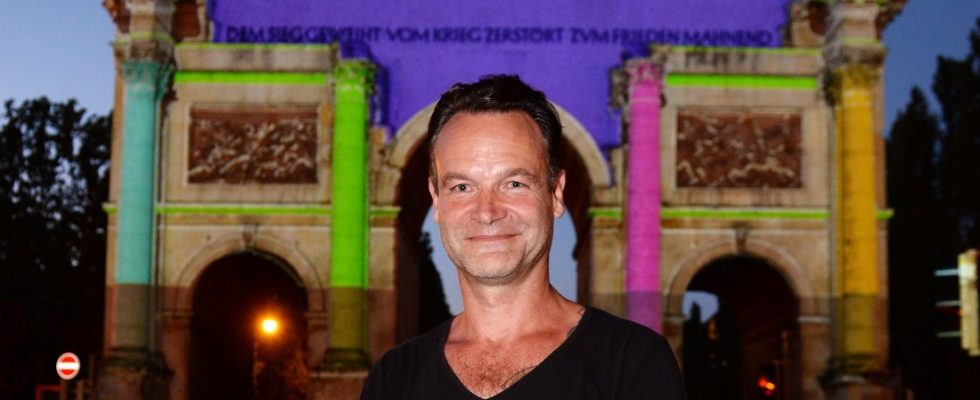Nothing can be heard from the audience in front of the victory gate when violinist Viktoria Sholupata plays the piece “Melody” by Myroslaw Skoryk. Is it just concentration that you can see on the young Ukrainian woman’s face on the evening of August 19th, or is there also a little pain, maybe even sadness? Some of those present are in tears. When the piece ends, the applause is even louder. Then Sholupata’s expression changes: for a moment she beams.
Hundreds of people came to the concert on Munich’s Ludwigstrasse, but the violinist was not among them. She is in Lviv at this moment. Everyone looks excitedly at the victory gate, onto which Sholupata is projected, framed by blue and yellow animations. At the same time, the musician sees the audience life-size. How it works? Through the video tool eLive. At first glance, it works similarly to Zoom or Skype, except that the quality of the transmission is significantly better and is suitable for concerts.
Till Kaestner had the idea for this. He developed it the way many experienced idea implementers work: together with others. For example with Chris Furtner, an expert in the field of live broadcasting, who is himself a musician and is in the Oktoberfest band Munich discord plays, and with Rüdiger Linhof, bassist Sports friends Stiller.
Kaestner, who has already founded several companies such as a tech start-up, is a big man. Not metaphorically, but literally. It measures well over two meters. But even if he were smaller, he would probably take up any room with his friendly, yet determined manner. His arms and legs are decorated with many tattoos, some of which are inspired by pop culture. However, it is difficult to see the images more precisely when you talk to Kaestner because he is constantly gesticulating.
In 2020, during the first lockdown, Kaestner got a call from a friend who said: “Do something so artists can perform in my living room.” Kaestner turned to a media entrepreneur friend, who in turn put him in touch with Furtner and Linhof. Together they then thought, planned and developed the result: a box measuring around 60 x 60 x 25 centimeters and weighing ten kilos. Small enough for hand luggage on an airplane.
In order to put on a remote live concert like at Siegestor, both the musician and the organizer must have such a box. The artists then have to connect a microphone and a camera – and if they want to see the audience, ideally a projector. In a pinch, a smartphone is enough.
Sholupata in Lviv at the concert in Munich.
(Photo: Nils Nebe/oh)
Dietmar Lupfer, managing director and co-founder of Muffatwerk, can imagine using such technology where a classic live event is not possible. However, regularly replacing concerts with a digital broadcast is out of the question for him: As a musician, you go on stage to get feedback from the fans and feel the audience.
“Founding a start-up is like jumping off a cliff and building an airplane as you fall,” a former colleague once said to Kaestner. “The cliff here was pretty high,” he admits. Because actually not much could go wrong. Furtner had the technical know-how, Linhof had contacts and concert experience.
“Culture is one of the great pillars of our society and we are trying to make it more democratic and diverse,” says Linhof, for whom the concert at the Victory Column was a complete success. The connection to Sholupata also came through him. Exchange with Ukraine has been a major concern of his since the beginning of the war: “If we transport culture out of Ukraine, we create identity; if we transport culture into Ukraine, then we create solidarity.” Sholupata herself says that she is happy to make her art “available to everyone in the world.” The audience also seems enthusiastic about their concert. “I think it’s really, really nice that she lets us enjoy her music here in Munich,” says a visibly moved audience member.
Till Kaestner’s work for the LinkedIn platform took him to Munich about ten years ago. At that time, he said, he helped set up the company’s German location. He sees a great opportunity for his company in the fact that regular concerts have become significantly more expensive due to the pandemic and the resulting loss of jobs in the event industry. This type of concert not only saves money, but also emissions, he emphasizes. In the meantime, the team is working on packaging the technology even more efficiently – the boxes should be smaller and lighter.
Sholupata’s concert doesn’t last particularly long, because when it’s 10 p.m. in Munich, there’s a curfew in Lviv. But the twenty minutes she played were all the more intense. It’s an encounter that wouldn’t have happened without eLive’s patented technology. Of course, she can’t give autographs like this. You may have to forego stage diving and after-show parties more often in the future, because you can’t get close to stars through eLive.

